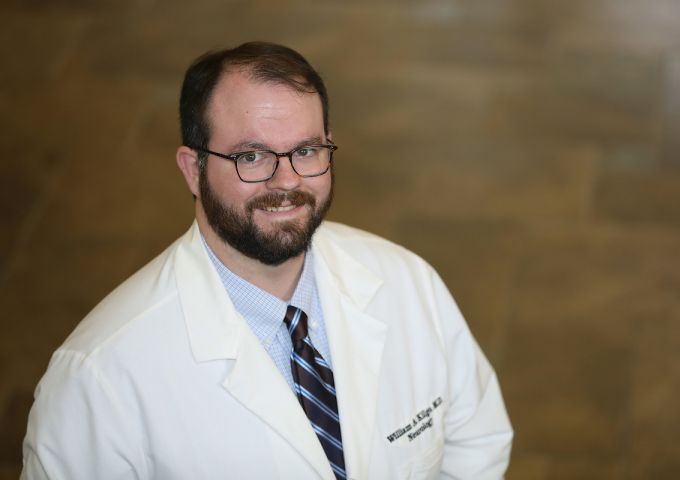
Resident physicians partner with Orange Beach first responders to improve emergency care
Rotation for emergency medicine residents sends them on calls with paramedics and firefighters in Orange Beach. The goal: sharpen their skills to provide better care.
By Lindsay Lyle
[email protected]
Patient care doesn’t start when a patient is offloaded from a gurney in the hospital’s emergency department.
“It starts in the field,” said Paul Henning, M.D., associate program director of the Emergency Medicine Residency Program at USA Health and medical director of Orange Beach Fire/Rescue. “The expertise that a patient gets in the field can determine outcomes.”
Henning, who also serves as an associate professor of emergency medicine at the University of South Alabama College of Medicine, said it is vital that physicians understand what happens in the prehospital stage of care.
For that reason, residents in USA Health’s Emergency Medicine Residency Program, established in July 2019, are given the opportunity to rotate with emergency medical services (EMS) in Orange Beach, Ala. Stationed at the Orange Beach Fire Department, resident physicians respond to emergency calls alongside paramedics and firefighters.
“It bridges the gap between the physician and the paramedic. Seldom, if ever, do physicians have this kind of exposure to prehospital emergency services,” Henning said. “It also gives the physician more perspective of what the paramedics are doing in the field. If we have an opportunity to improve the prehospital scope of practice, then we have accomplished our goals.”
Justin Thomas, M.D., a second-year emergency medicine resident, was the first USA Health resident to rotate in Orange Beach. He said the experience opened his eyes to the constraints paramedics endure while working in the field, particularly when responding to calls in rural areas of the county.
“There are locations they respond to that may be in the middle of the woods, or down a dirt road someone only goes down once every couple of weeks,” Thomas said. “They have to lug their supplies and the stretcher to the house, assess and care for the patient, and then bring them to the ambulance.”
The medics are also limited by the supplies and tools they have with them, Thomas said. “It’s much different being at a hospital with all the resources at your disposal versus working from an ambulance with limited capabilities.”
Thomas, who earned his medical degree from the American University of the Caribbean, took a nontraditional route to emergency medicine. As a resident in USA Health’s Family Medicine Residency Program, he rotated in the emergency department at University Hospital and was attracted to the field.
After graduating from his family medicine residency in June 2019, Thomas was offered a spot in the new Emergency Medicine Residency Program. With approval from the American Board of Emergency Medicine, he was able to start as a second-year because of his months of training in emergency medicine during his family medicine residency.
Andrew Warner, M.D., also took a nonlinear path to emergency medicine. A former Green Beret, Warner served with the U.S. Army 5thSpecial Forces Group on tours in Iraq and Afghanistan. He went on to earn his medical degree from the University of Cincinnati College of Medicine. Like Thomas, he completed his residency training in family medicine at USA Health and started in the emergency medicine program as a second-year resident.
Warner has great respect for the Orange Beach first responders, who “epitomize true dedication to patient care and outcomes,” he said. “I have further learned to appreciate just how critical those precious seconds in the prehospital setting are for patient survivability.”
The partnership is mutually beneficial for USA Health’s emergency medicine residency program and Orange Beach’s paramedical and fire-rescue services. Resident physicians and paramedics are able to provide a higher level of care to patients while learning from one another.
“I love to hear the interaction between our staff and the residents,” said Orange Beach Fire Chief Mike Kimmerling. “Even when they’re not running calls, there is a tremendous amount of knowledge being transferred in their conversations.”
Residents gain more diversity of exposure in Orange Beach than in a larger city like Mobile, Henning said. “Most fire and rescues in large cities are close to hospitals, so the transport time is usually 10 minutes or less, whereas in Orange Beach the time could be significantly longer,” he said. “When they are able to render care for a longer period of time, they have the chance to sharpen their skills and have more patient exposure.”
In Orange Beach, they also gain unique experiences working on fire and rescue boats, he added.
Before starting the EMS rotation, the residents are required to be fully licensed by the state and to have completed an online medical direction course, Henning said. If any questions or concerns arise, Henning and other emergency medicine attending physicians with USA Health are always available to provide their medical direction.
In addition, residents cannot start the EMS rotation until their second year. As the first class of residents graduate to their second year, six residents will rotate throughout the academic year, plus third-years have the option to do an additional EMS rotation, Henning said.




